
Author: Chris Fastie
Test Flight
Ever since I backed the balloon mapping Kickstarter project, I have been thinking about what to do with the matched pair of visible and infra-red cameras I will receive next month. I’m intrigued by the idea of making NDVI images by combining information from the two cameras. NDVI maps of vegetation can reveal new ecological patterns, but I still have no idea what I might learn with this tool. I have also been thinking about how to deploy the cameras to take aerial photos. The level of my Kickstarter pledge entitles me to a kit with cameras and other things, but it is not yet clear what other things will be included. So when it was 50° a couple of weeks ago and tolerable to work in the garage, I started playing with a piece of one of the aluminum storm window frames that were thrown behind the shed. The goal was to make a cheap, lightweight, self-leveling rig to hold two cameras pointing in the same direction: down. Continue reading “Test Flight”
Propain
(1/31/2012 update at bottom)
Most of the heat in my house is generated by a wood stove which burns three or four cords of wood a year. When the temperature stays below 20° F for a few days, I let the thermostat turn on the oil furnace for three hours in the morning to take the chill off, but I rarely use the furnace to heat the entire house all day long. I also have a propane space heater in one room that runs on most winter days. Propane is also used to heat water and for the kitchen range, and I use about 350 gallons per year.
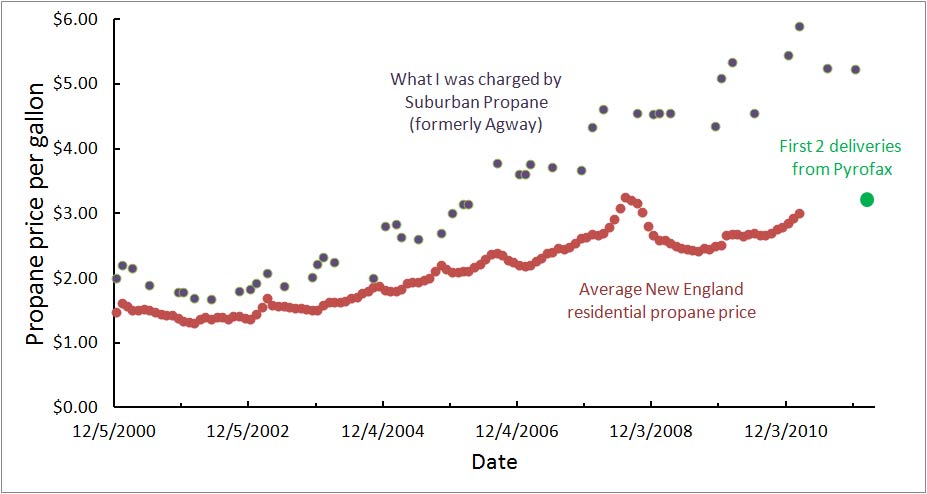
Return to the Marsh
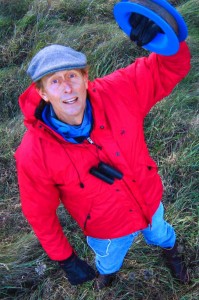
Above Crown Point
In honor of the opening of the new Crown Point Bridge across Lake Champlain (scheduled for Monday, November 7, 2011) I took my last free ferry ride and flew the Canon Powershot S95 over the Crown Point State Historic Site for three hours last week. The south wind was strong and steady at about 15 mph, but the Levitation Delta kite wandered a bit much to get good coverage for easy panorama stitching. I learned some new finesses of Microsoft ICE and was able to make some decent scenes with as many as 28 stitched photos, but could not construct a half-spherical panorama.
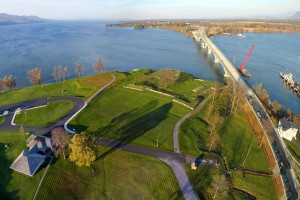
Otter View Park
It didn’t seem windy enough, so I plucked dried heads of orchard grass and tossed them into the air. The live feed at WeatherUnderground.com had been reporting 10-12 mph NW winds at the Ralph Myhre Golf Course a mile away, but the grass was falling almost straight down here. On a knoll in the center of the field I felt a breeze, so I took off my pack and assembled the nine foot Levitation Delta kite (with wind less than 15 mph, the Sutton Flow Form 16 would stay in the pack). The delta flew out of my hand and climbed easily to 100 feet. It was flying to the south, not to the east over the cattail marsh I wanted to photograph. Otter View Park in Middlebury is the focus of Galen’s community service project, and he has been describing the plant communities in that marsh. I would not be able to photograph much of it today unless the wind shifted. Continue reading “Otter View Park”
Return to the Nubble
I went over to the Adirondacks last Wednesday and came back with 1900 photos. Most of them were taken by my Gigapan imager, and half of those are duplicates that will never again see the light of day. Before I even got to New York, I took 126 handheld photos from the Lake Champlain ferry, 48 of which got stitched into the three-row panorama below of the new Crown Point Bridge, still under construction. Back on August 26, the day the central “network tied arch” was lifted into position, I came to repeat the gigapan I took of the old bridge. But the place was crawling with gawkers, and the men in hard hats would not let me get to the place from which the earlier panorama had been taken. So I left defeated. If you missed it too, you can relive the raising of the arch with the fully archived construction webcams, but you have to click through a lot of photos to get to 3:30 PM on August 26 when the action started. Continue reading “Return to the Nubble”
NOrtho Photo
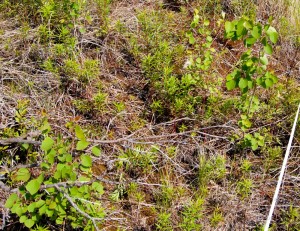
While in Alaska in June I visited some mountain treeline study plots we established in 1998 to describe and monitor the population of white spruce at the transition between subalpine forest and alpine tundra. I searched the plots for new spruce seedlings and remeasured the ones that had been previously located and marked. A wildfire burned through some of the plots in 2004, and a new tree species has since established where the organic soil was consumed. Thousands of seedlings of quaking aspen now grow in the plots, and I recorded their number and height in subplots. These are healthy seedlings growing in the tundra where, prior to 2004, the only trees were a few stunted spruce. This invasion will be either a short-lived experiment that ends when the aspens try to grow taller than the winter snowpack, or the start of a novel treeline community. Monitoring these plots will eventually reveal how this plays out, so in the meantime counting and measuring a few things is considered to be science. Continue reading “NOrtho Photo”
Giant Mountain
Somehow I convinced myself that the 4626 foot summit of Giant Mountain in the Adirondacks would be a good place to take some photos with a camera hanging from a kite. Yesterday I walked up there with two kites, three cameras, two KAP rigs, 1000 feet of line, and one sandwich. I think it might be possible to fly a kite up there sometime, but most of the time the wind on a mountain peak is not just blowing horizontally, it is moving up slope. This was obvious when I easily got the delta kite in the air from the summit and it tried to fly into the wind, over my head, and down the slope behind me. I realized that kites are designed to fly in wind that is perpendicular to gravity. When this geometry is lost, erratic behavior results, and the kite landed in a tree twice. Continue reading “Giant Mountain”
Little Tupper #5
Last weekend we made our fifth annual paddle trip to Little Tupper Lake with the same people, the same menu, and (as always) a new campsite. It was the second year we had to take a ferry from VT to NY instead of the Crown Point Bridge which is being replaced. The Photosynth panorama below of the new bridge was stitched from 12 handheld photos taken from the ferry at the dock.
I have made two Picasa albums from the trip. One has photos taken by a small camera attached to a kite line, and the other has photos taken by a DSLR which stayed close to, and more securely above, the lake surface. Below is a slide show from the KAP album. Continue reading “Little Tupper #5”
Bread Loaf
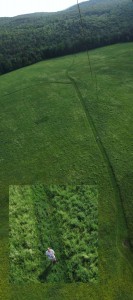
Photosynth Thesis
A couple of weeks ago I took some photos and video from the KAP rig lofted on the Flow Form 16 kite above a clearing behind the house. I did not get far stitching the images into a panorama, and had to move on to other business. Since then I have used Photosynth, which will not only display stitched panoramas, but the multiple unstitched overlapping images. The photos do not need to be taken from the same place, so KAP images should be well suited. Photosynth will create and display a 3D model of the surfaces in the photographs. The model consists of the points that Photosynth has determined are shared in two or more photos, and the 3D plot of those points based on photogrammetric analysis of the images. You can toggle a display of the point cloud in the Photosynth viewer below. Continue reading “Photosynth Thesis”
